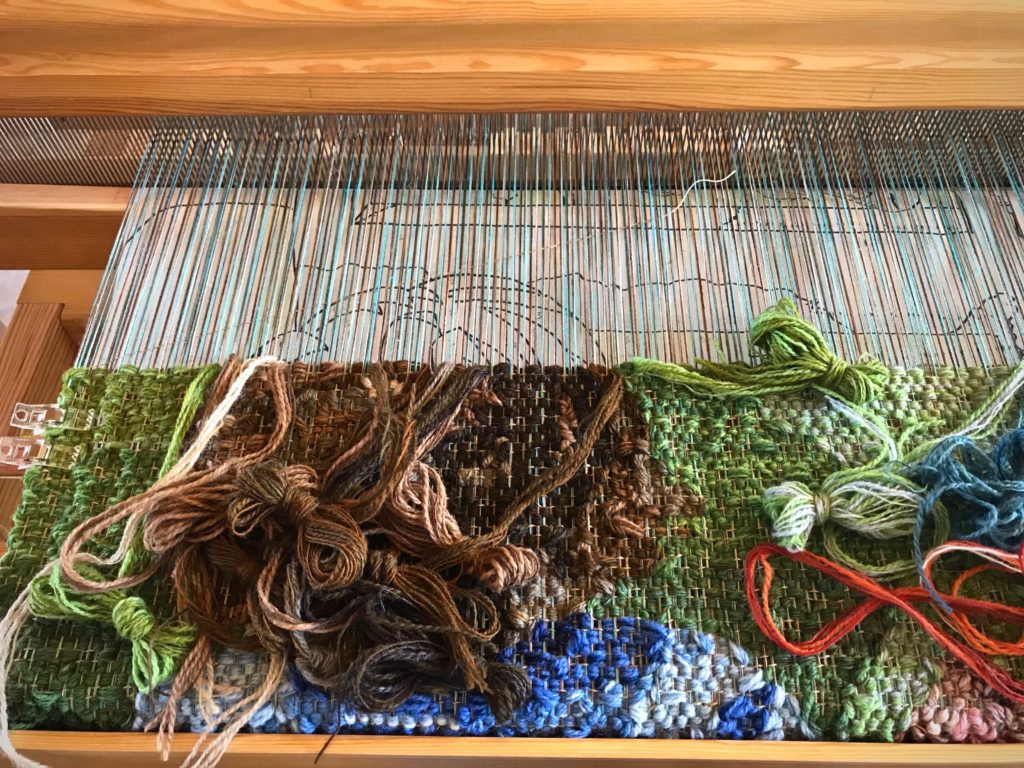The best thing about weaving a pictorial tapestry? Having a cartoon to follow, with row-by-row definition. This Siblings tapestry has its joys and challenges. It is a joy to weave Ari’s hair, as if I get to comb his locks into place. At the same time, it’s a challenge to see up close what can only be recognized at a distance. Lucia’s shirt is a joy to weave because of the bright colors and distinct shading. But what a challenge to get the right value of turquoise for the leg of the rabbit hutch in relation to the value of orange in Lucia’s left shoulder.


The yarn is my paint. I make decisions and adjustments as I see how the colors interact. Under the warp, of course, is my cartoon with all the details—outline, hues, value changes. That cartoon is constant, unchanging, and reassuring. It’s the key to this whole process.


In the joys and challenges we face, we make decisions based on what we see. Take a look below the surface. Look through the warp to see the cartoon. True love is in the details. Jesus instructs and guides through his love. Constant, unchanging, and reassuring. It makes perfect sense to follow the Maker’s cartoon.

May you grow in love.
With joy,
Karen

I admire your patience…and very much so, your talent.
Hi Beth, Thank you so much for your thoughtful insights. You’re making me reflect on patience and talent. Patience doesn’t seem hard for me most of the time—at the loom, at least. I like the whole slow process, so I’m not in a hurry about it. Talent, on the other hand, seems elusive. I think patience and talent may be related. The more patient I am to practice what I know, the more talented I get. 🙂
Happy weaving,
Karen
Good morning Karen,
You are an artist nose to toes. To do the weaving that you do requires a working skill of the craft. No matter how much I tried, the skill to make music from the viola was not possible because the craft was beyond my physical ability. As much as the mind desires, without the craftsmanship foundation to describe creativity, nothing happens. Mathematics, so necessary with science and engineering and business. Color theory with the visual. Mechanical understanding of the instrument, viola or loom or CNC or human body.
You are constantly sharing as you explore the craft of weaving. Your craftsmanship is honed to the best it can be. With that, the blessing of being an artist occurred. It is like running barefoot in a field as a child with no cares… Just the freedom of no boundaries.
God has blessed you with being a textile artist and you have extended that to the world with your blog.
Praise God. Thank you Karen.
Nannette
Hi dear Nannette, What a beautiful thing for you to say! I will take it to heart.
Love,
Karen
Hi,
I love all your work and follow your posts religiously. I’m so interested to see your latest posts about your tapestries, not only because they are as wonderful as everything you weave is, but because it seems to me that you are following very closely the way Helena Hernmarck weaves hers: specifically, the colored warp and stepping up above the tapestry to see the effect through the back end of binoculars. Did you take a class with her or have you been watching the few videos that exist about her process? I’m particularly interested in how to select the colors for the multi-colored warp. If you can point me to a how-to, I would be most grateful. Thank you for writing your blogs!
Robyn Tanchum
Hi Robyn, It’s true, I am familiar with Helena Hernmarck’s work and admire it very much. I was fortunate to take a Pictorial Tapestry workshop taught by Joanne Hall. I use the techniques Joanne taught me, which are similar in some ways to the work of Helena Hernmarck, but different as well.
The warp uses three strands of 16/2 linen as a single end. I choose the warp colors to go with the colors that are in the tapestry. I like the warp to have color, and I try to stay away from black or white.
Thanks for your kind encouragement,
Karen